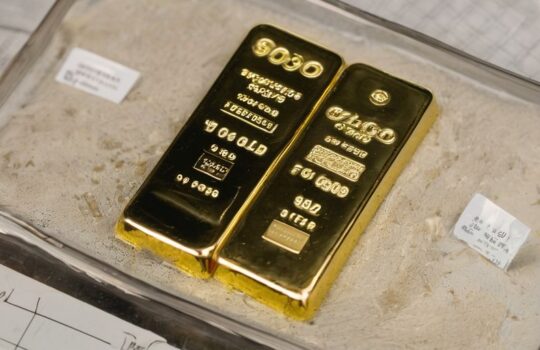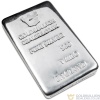Current Trends in the UK’s 1 oz Gold Bar Price: An Investor’s Guide

The current trends in the UK’s 1 oz Gold Bar price are influenced by various factors and market dynamics. In this article, we will explore the key factors affecting gold prices in 2023, analyse the GBP/USD technical outlook, examine the impact of US inflation on currency pairs, and discuss strategies for navigating the bear market.
Key Takeaways
- Geopolitical risk and market sentiment play a significant role in influencing gold prices.
- GBP/USD analysis indicates potential breakout opportunities and the influence of monetary policy decisions.
- US inflation data has a direct impact on currency pairs, including USD/JPY, GBP/USD, and EUR/USD.
- Interest rate decisions and market sentiment dynamics are crucial for navigating the bear market.
- Market sentiment, geopolitical risk, and inflation dynamics are key factors to consider in gold price analysis.
Factors Influencing Gold Prices in 2023

Interest Rates and Their Impact
Interest rates are a fundamental driver of gold prices, and the Bank of England’s (BoE) monetary policy decisions in 2023 have been closely watched by investors. Higher interest rates typically strengthen the GBP, making gold more expensive for investors holding other currencies. Conversely, lower rates can lead to a weaker pound and cheaper gold prices in foreign currency terms.
Monetary policy adjustments are often anticipated by the market, but the actual decisions can still lead to significant volatility. For instance, unexpected rate hikes or dovish statements can cause abrupt price movements. Here’s a brief overview of the recent trend:
- BoE’s last rate decision led to a temporary spike in gold prices.
- Subsequent market corrections adjusted the prices, reflecting the new interest rate outlook.
- Investors remain cautious, awaiting further cues from upcoming policy meetings.
In the context of a dynamic economic landscape, the interplay between interest rates and gold prices remains a critical consideration for portfolio diversification strategies.
Geopolitical Risk and Market Sentiment
The interplay between geopolitical risk and market sentiment is a critical driver of gold prices. Investors often flock to gold as a safe haven during times of geopolitical uncertainty, which can lead to a surge in demand and consequently, an increase in price. The volatility in the market due to geopolitical events can be observed through various indicators:
- Shifts in gold futures trading volumes
- Changes in the price of gold-related ETFs
- Fluctuations in safe-haven currency pairs (e.g., USD/JPY)
The sentiment in the gold market is also heavily influenced by the actions and statements of central banks and governments around the world. Their responses to geopolitical events can either amplify or mitigate the market’s reaction.
It is essential for investors to monitor these developments closely, as they can have both immediate and long-term effects on the value of gold. Understanding the nuances of market sentiment in relation to geopolitical risks can provide investors with an edge in making informed decisions.
China’s Influence on Gold Demand
The influence of China on the global gold market cannot be understated, particularly in 2023. China’s 2023 gold demand rises on strong central bank buying, reflecting the country’s growing appetite for the precious metal. The Shanghai Gold Benchmark Price, a key indicator of local gold prices, rose 17% in 2023, significantly outperforming other major yuan-denominated assets.
Central bank purchases have been a driving force behind this surge, as China continues to diversify its reserves away from the US dollar. The increased demand from China has implications for global gold prices, potentially leading to higher prices worldwide.
The robust demand in China is not only a testament to the country’s economic resilience but also an indicator of the strategic importance it places on gold as an asset class.
The following points highlight the key aspects of China’s influence on gold demand:
- The role of the Shanghai Gold Benchmark Price as a barometer for China’s gold market.
- Central bank policies and their effect on gold reserves.
- The impact of China’s economic health on global gold demand.
GBP/USD Technical Analysis

Key Resistance Levels and Potential Breakout
The GBP/USD pair has been exhibiting signs of volatility within a lateral channel, suggesting a period of consolidation before a potential breakout. Traders are closely monitoring the critical support and resistance levels, which could indicate the future direction of the currency pair.
Resistance levels are particularly significant as they represent the threshold that buyers struggle to overcome. A breakout above these levels often signals a shift in market sentiment from bearish to bullish. The following table highlights key resistance levels to watch:
| Level (GBP/USD) | Significance |
|---|---|
| 1.2615 | Critical Support |
| 1.2595 | Support Level |
| 1.2757 | Upper Resistance |
Should the pair push through the upper resistance at 1.2757, it could confirm a bullish trend, enticing more buyers into the market. Conversely, a rejection at this level might see the pair retreat to test lower support levels.
In the context of the broader market, the influence of the MACD and Marlin Oscillator on trading patterns cannot be overstated. These technical indicators help traders discern possible price reversals and momentum shifts.
MACD and Marlin Oscillator Influence
The GBP/USD pair has been exhibiting signs of potential reversal as the Marlin Oscillator signals a downward turn. Traders are closely monitoring the Moving Average Convergence Divergence (MACD) for indications of momentum shifts. A bearish crossover in the MACD could confirm the Marlin’s prognosis, suggesting a strengthening of the bearish trend.
Technical analysis of the GBP/USD pair reveals key levels to watch. Should the MACD align with the Marlin Oscillator’s bearish signal, the following support levels could come into play:
- Immediate support at 1.0882
- Next critical support level
Investors should remain vigilant as these technical indicators can provide early warnings of a trend change, which is crucial in a volatile market.
The influence of these oscillators is not to be underestimated, as they often precede significant price movements. The website page features Umicore and Metalor silver bars, with options for estimating shipping rates and contacting the seller, which may also interest gold investors seeking to diversify their portfolio.
Impact of BoE Monetary Policy Decisions
The Bank of England’s (BoE) monetary policy decisions have a profound effect on the GBP/USD currency pair. Investors closely monitor the BoE’s interest rate announcements, as they can significantly sway the pound’s strength. A hawkish stance, suggesting higher interest rates, typically bolsters the GBP, while a dovish outlook can lead to depreciation.
Monetary policy minutes and reports provide insights into the economic considerations driving these decisions. For instance, a balanced debate in the BoE’s next meeting could indicate uncertainty, affecting investor confidence and the subsequent pricing of 1 oz gold bars in GBP.
The anticipation and aftermath of policy announcements often result in heightened volatility for the GBP/USD pair. Traders should prepare for potential fluctuations during these periods.
Here’s a snapshot of recent BoE policy impacts on the GBP/USD pair:
- Hawkish signals lead to a short-term GBP rally.
- Dovish statements correlate with a GBP decline.
- Policy surprises can trigger abrupt market movements.
Understanding these dynamics is crucial for investors looking to capitalise on gold price trends in relation to GBP valuation.
US Inflation and Its Effects on Currency Pairs

Anticipated Impact on USD/JPY Pair
The anticipation surrounding US inflation data, particularly the Personal Consumption Expenditures (PCE) Price Index, has significant implications for currency pairs. A higher-than-expected PCE figure could reinforce the prospect of sustained or heightened Federal Reserve rates, potentially lifting the USD/JPY pair above short-term resistance levels. This dynamic underscores the sensitivity of the pair to US economic indicators.
In the context of the GBP/USD pair, the reaction to US inflation data is twofold. On one hand, a strong USD buoyed by inflationary pressures may lead to a depreciation of the GBP against the USD. Conversely, if the data suggests a cooling of inflation, the GBP could find support, as expectations for aggressive Fed rate hikes may diminish.
The interplay between US inflation data and central bank policies remains a critical factor for investors to monitor, as it directly impacts currency valuations and trading strategies.
Market sentiment also plays a crucial role, as investors’ perceptions of economic health and monetary policy effectiveness can cause swift changes in currency pair valuations. The following table highlights recent movements in the GBP/USD pair in response to US inflation data releases:
| Date | US Inflation Data | GBP/USD Reaction |
|---|---|---|
| 2023-03-15 | Above Expectations | Depreciated |
| 2023-04-12 | Below Expectations | Appreciated |
Understanding these trends is essential for investors navigating the volatile forex market, especially during periods of economic uncertainty.
GBP/USD Reaction to US Inflation Data
The anticipation of US inflation data releases often triggers significant volatility in the GBP/USD currency pair. Investors closely monitor these figures as they can influence the Federal Reserve’s monetary policy decisions, which in turn affect the dollar’s strength. A lower-than-expected inflation rate may lead to a dovish stance from the Fed, potentially weakening the dollar and causing the GBP/USD to rise.
Conversely, if inflation figures exceed expectations, the market may anticipate a more hawkish Fed, strengthening the dollar and applying downward pressure on the GBP/USD. The table below summarises the recent market reactions to US inflation data:
| US Inflation Rate (%) | Expected | Actual | GBP/USD Reaction |
|---|---|---|---|
| 3.0 | 3.2 | 2.9 | Rose slightly |
| 3.0 | 3.1 | 3.2 | Fell marginally |
In the context of currency pairs, it’s crucial to understand that the GBP/USD is not only influenced by US economic indicators but also by UK domestic events. For instance, the UK wage growth easing to 7.3%, below expectations, can also sway the pair, underscoring the complexity of forex market dynamics.
EUR/USD Weekly Trend Analysis
The EUR/USD pair has shown a consolidation pattern, hinting at potential upside momentum. However, the bearish channel persists, suggesting a cautious approach for traders eyeing key support levels for entry points. Technical analysis indicates a possible bottom forming, which could signal a reversal if accompanied by positive economic data.
- Bearish momentum near key support levels
- Consolidation with potential for upside
- Impact of US labour data on Euro momentum
The market’s reaction to the latest economic releases will be pivotal in determining the EUR/USD’s direction in the coming week.
As investors navigate the forex market, it’s crucial to stay updated with live analysis and forecasts. DailyFX provides timely insights into the EUR/USD rate, helping traders make informed decisions.
Navigating the Bear Market

Impact of Interest Rate Decisions
Interest rate decisions are a pivotal factor in the valuation of gold and currency pairs. Central banks’ policies, particularly those of the Bank of England (BoE), significantly influence investor sentiment and market dynamics. A hike in interest rates typically strengthens the pound, making gold more expensive for investors holding other currencies.
The anticipation and aftermath of interest rate announcements often trigger volatility in the markets, affecting the price of 1 oz gold bars.
The following table illustrates the recent trend in interest rate decisions and their immediate impact on the GBP/USD pair:
| Date | BoE Rate Decision | Immediate GBP/USD Reaction |
|---|---|---|
| 01/03/2023 | 0.25% Hike | 1.2% Increase |
| 01/04/2023 | Hold at 4.1% | 0.5% Decrease |
As investors navigate the bear market, understanding the correlation between interest rate decisions and gold prices is essential. The strategic positioning of investments before and after such announcements can be crucial for portfolio performance.
Inflation Dynamics and Market Sentiment
In the complex dance of market forces, inflation dynamics play a pivotal role, often dictating the tempo for investor sentiment. As inflation rates fluctuate, they can either erode or enhance the value of gold as an asset. Investors closely monitor inflation indicators to gauge the potential impact on their portfolios, particularly in the context of gold investments.
The relationship between inflation and gold prices is historically inverse; as inflation rises, the purchasing power of currency falls, leading investors to seek refuge in gold. However, the current economic landscape presents a nuanced picture, with central banks’ responses to inflation adding another layer of complexity.
The sentiment in the market is a reflexion of collective investor psychology, influenced by a myriad of factors including inflation data, monetary policy decisions, and geopolitical events.
Understanding the interplay between inflation dynamics and market sentiment is crucial for investors looking to navigate the bear market. Here’s a brief guide to consider when evaluating the best price for a 1 oz gold bar in the UK:
- Assess the purity of the gold bar.
- Evaluate the reputation of the seller.
- Analyse current market conditions.
- Explore different buying options.
- Compare prices across sellers.
- Stay informed about factors affecting the price of gold.
Market Sentiment and Geopolitical Risk
In the realm of gold investment, market sentiment and geopolitical risk are closely intertwined, often driving the volatility of gold prices. Despite a backdrop of economic uncertainty, gold has demonstrated resilience, as highlighted by the recent surge to a new high of $2078/oz. This peak in price reflects a complex interplay of factors, where geopolitical tensions can lead to a ‘flight to safety’, bolstering gold’s appeal as a haven asset.
The following points outline the impact of market sentiment and geopolitical risk on gold prices:
- The perception of increased geopolitical risk typically leads to higher demand for gold.
- Market sentiment can shift rapidly in response to global events, influencing gold investment decisions.
- Gold prices may react to geopolitical events differently depending on the nature and location of the incident.
The intricate relationship between market sentiment and geopolitical risk necessitates a vigilant approach to gold investment, where understanding the nuances of each can provide a strategic advantage.
Conclusion
In conclusion, the current trends in the UK’s 1 oz Gold Bar price present a complex landscape influenced by a multitude of factors. From geopolitical risks to economic uncertainty, the gold market is navigating through a challenging environment. The recent fluctuations in gold prices, amidst shifts in currency values and global market dynamics, highlight the need for investors to carefully analyse and adapt to changing conditions. As the UK’s gold market continues to evolve, staying informed and agile will be crucial for investors seeking to navigate this dynamic landscape.
Frequently Asked Questions
What are the key factors influencing gold prices in 2023?
The key factors influencing gold prices in 2023 include interest rates, geopolitical risk, market sentiment, and China’s influence on gold demand.
How does GBP/USD technical analysis impact gold bar prices?
GBP/USD technical analysis can impact gold bar prices by indicating key resistance levels, potential breakout scenarios, and the influence of MACD and Marlin Oscillator. Additionally, the impact of Bank of England monetary policy decisions is also a significant factor.
What is the anticipated impact of US inflation on currency pairs?
US inflation is anticipated to impact currency pairs such as USD/JPY, GBP/USD, and EUR/USD. It may also influence weekly trend analysis and the reaction of these currency pairs to US inflation data.
How can investors navigate the bear market in relation to gold bar prices?
Investors can navigate the bear market in relation to gold bar prices by considering the impact of interest rate decisions, inflation dynamics, market sentiment, and geopolitical risk.
What are the potential trends in GBP/USD and their influence on gold bar prices?
The potential trends in GBP/USD, including potential delay in rise, testing of key resistance levels, and dominance of bulls on lower timeframes, can influence gold bar prices.
How do economic factors such as interest rates and inflation impact gold bar prices?
Economic factors such as interest rate decisions and inflation dynamics can have a significant impact on gold bar prices, especially in the context of market sentiment and geopolitical risk.










